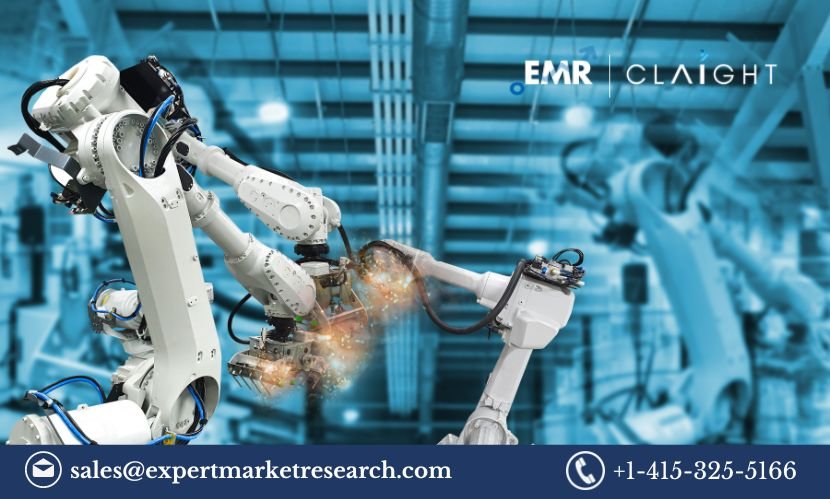Industrial Robots Market Outlook
According to the report by Expert Market Research (EMR), the global industrial robots market size reached a value in 2024. Driven by the increasing demand for automation, advancements in robotic technologies, and the need for enhanced production efficiency across industries, the market is expected to grow at a compound annual growth rate (CAGR) of 11.4% from 2025 to 2034.
Industrial robots are automated machines designed to perform manufacturing tasks with high precision and efficiency. These robots are widely used in various industries, including automotive, electronics, food and beverage, pharmaceuticals, and consumer goods, to automate repetitive processes, reduce human error, increase productivity, and ensure consistency in production. With continued advancements in artificial intelligence (AI), machine learning, and robotics engineering, the industrial robots market is poised for significant growth over the coming years.
Growth Drivers
The key factors contributing to the growth of the global industrial robots market include the growing need for automation, increasing labor costs, the rise of Industry 4.0, and the demand for higher production efficiency. Industrial robots are increasingly being utilized to enhance manufacturing processes in diverse industries. Automation offers numerous advantages, such as reducing human error, improving operational efficiency, and lowering production costs.
One of the major drivers of the industrial robots market is the growing labor shortage, particularly in developed economies. As the workforce ages and labor costs continue to rise, manufacturers are turning to robots to fill the gap. Robots offer the advantage of being able to work 24/7, which not only increases productivity but also improves production flexibility.
Furthermore, the advancement of Industry 4.0, which integrates smart technologies such as the Internet of Things (IoT), AI, and big data analytics, is pushing the adoption of industrial robots. These technologies enable robots to perform more complex tasks with greater autonomy, efficiency, and flexibility, making them an attractive solution for modern manufacturing processes.
The COVID-19 pandemic has also played a role in accelerating the adoption of industrial robots. As businesses faced disruptions to their supply chains and manufacturing operations, the need for automation became even more evident. Robots are capable of operating in environments with limited human interaction, ensuring continuity in production during challenging times.
Get a Free Sample Report with Table of Contents- https://www.expertmarketresearch.com/reports/industrial-robots-market/requestsample
Technological Advancements and Applications
The industrial robots market is being shaped by several technological advancements that are enhancing the capabilities of robots and expanding their range of applications. One such advancement is the development of collaborative robots, or cobots. Unlike traditional industrial robots that operate in isolation from human workers, cobots are designed to work alongside humans in a shared workspace. These robots are equipped with advanced sensors and AI algorithms to ensure safe interaction with human operators. Cobots are particularly popular in small- and medium-sized enterprises (SMEs) that may not have the resources to implement large-scale automation systems.
Another significant technological advancement is the increasing integration of artificial intelligence and machine learning into industrial robots. AI-powered robots can analyze data from sensors, adapt to changing conditions, and optimize their actions in real-time. This capability allows robots to perform tasks such as quality inspection, assembly, and packaging with greater accuracy and efficiency. Additionally, AI-driven robots can learn from previous tasks, improving their performance over time.
The rise of automation in industries such as automotive manufacturing has also contributed to the increased adoption of industrial robots. Robots are used in a wide variety of tasks in the automotive sector, including welding, painting, and assembly. These robots provide high precision and consistency, which are essential for meeting quality standards and reducing defects.
In the electronics and semiconductor industries, robots are used for delicate tasks such as component assembly, testing, and packaging. The high precision required in these applications has driven the demand for industrial robots with advanced motion control and sensing capabilities.
The food and beverage industry is another sector benefiting from industrial robots. Robots are used in food processing, packaging, and palletizing, helping to increase throughput, maintain hygiene standards, and reduce labor costs. Additionally, the ability to automate these processes allows manufacturers to meet growing consumer demand and maintain consistent product quality.
Industrial Robots Market Segmentation
The market can be divided based on robot type, industry, and region.
Market Breakup by Robot Type
- Articulated
- SCARA
- Cylindrical
- Cartesian/Linear
- Parallel
- Others
Market Breakup by Industry
- Automotive
- Electrical and Electronics
- Healthcare and Pharmaceuticals
- Food and Beverages
- Rubber and Plastic
- Metals and Machinery
- Others
Market Breakup by Region
- North America
- Europe
- Asia Pacific
- Latin America
- Middle East and Africa
Competitive Landscape
The EMR report looks into the market shares, plant turnarounds, capacities, investments, and acquisitions and mergers, among other major developments, of the global industrial robots companies. Some of the major key players explored in the report by Expert Market Research are as follows:
- ABB Ltd
- Fanuc Corporation
- KUKA AG
- YASKAWA Electric Corporation
- Comau S.p.A.
- Seiko Epson Corporation
- Kawasaki Heavy Industries, Ltd.
- Mitsubishi Heavy Industries, Ltd.
- Others
Challenges and Opportunities
While the industrial robots market offers significant growth potential, there are several challenges that could impact its expansion. One of the primary barriers is the high initial cost of robotic systems. For small- and medium-sized enterprises (SMEs), the upfront investment required to implement automation can be a significant hurdle. However, the declining cost of robots, combined with their ability to reduce operational costs and increase productivity, is making automation more accessible to a wider range of businesses.
Another challenge is the need for skilled labor to operate and maintain industrial robots. While robots can reduce the need for manual labor, they require highly skilled technicians and engineers to program, troubleshoot, and maintain them. This skill gap may hinder the widespread adoption of industrial robots in certain regions and industries.
Despite these challenges, the opportunities in the industrial robots market are vast. As industries continue to prioritize automation to meet growing production demands, robots will play an increasingly central role in manufacturing. Moreover, the continuous development of more advanced robots, including cobots and AI-powered systems, is opening new opportunities in a wide range of industries, from healthcare and electronics to logistics and agriculture.
Media Contact:
Company Name: Claight Corporation
Contact Person: George buttler, Corporate Sales Specialist – U.S.A.
Email: sales@expertmarketresearch.com
Toll Free Number: +1-415-325-5166 | +44-702-402-5790
Address: 30 North Gould Street, Sheridan, WY 82801, USA
Website: http://www.expertmarketresearch.com
Aus Site: https://www.expertmarketresearch.com.au


